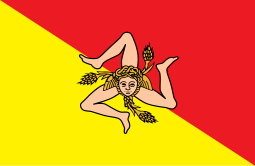Flag of Sicily
 |
|
| Name | Trinacria |
|---|---|
| Use | Civil and state flag |
| Proportion | 3:5 |
| Adopted | 4 January 2000 |
| Design | Divided diagonally from the upper hoist-side corner; the upper triangle is red and the lower triangle is yellow; in the center is the Sicilian triskelion featuring the Gorgon. |
The flag of Sicily (Sicilian: Bannera dâ Sicilia; Italian: Bandiera siciliana) was first adopted in 1282, after the successful Sicilian Vespers revolt against the king Charles I of Sicily.
The flag is characterized by the presence of the triskelion (trinacria) in its middle, the (winged) head of Medusa (Gorgon) and three wheat ears. The three bent legs allegedly represent the three points of the triangular shape of the island of Sicily, or the historical three valli of the island. The present design became the official public flag of the Autonomous Region of Sicily on 4 January 2000, after the passing of an apposite law which advocates its use on public buildings, schools, city halls, and all the other places in which Sicily is represented.
The flag is bisected diagonally into regions colored red and yellow, red representing the municipality of Palermo, yellow representing Corleone, which in medieval times was an agricultural city of renown. Palermo and Corleone were the first two cities to found a confederation against the Angevin rule.
The flag looks somewhat similar to the flag of the Isle of Man, especially for the use of the triskelion in both of these; today, the triskelion (or trisceli) is also widely considered the actual symbol of Sicily. The symbol is also known as the trinacria, which is also an ancient name of Sicily. The name was also revived and used during the Aragonese period of the Kingdom of Sicily immediately after the Sicilian Vespers (1282) which ended Angevin rule.
...
Wikipedia
